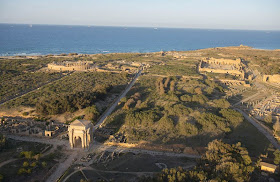The city was founded by the Phoenicians around 1000 BCE. The Romans acquired it in 146 BCE, when they conquered Carthage. It was a Roman ally but effectively independent until Tiberius incorporated it into the province of Africa around 20 CE. It became an important bastion of Roman power in Libya and a major trading center.
The city hit the big time when one of its sons, Septimus Severus, became emperor in 193 CE.
Septimus Severus and the rest of his Severan dynasty (193-235) massively beautified Leptis Magna, endowing it with baths, colonnades, a theater, the arch at the top of this post, and this huge basilica.
Details from the basilica.
The amphitheater.
As the empire declined, Leptis Magna was exposed to attacks from the Garamantes of the desert. It was the site of a famous scene described by the historian Ammianus Marcelinus that I always use to illustrate the problems of the late empire. When the city was besieged by desert brigands, its leaders wrote to the governor asking for help. He refused to send his soldiers unless the city agreed to pay all of the army's expenses during the expedition. He wanted more money to bring his soldiers than the brigands wanted to be paid to go away, so the city paid the brigands instead. Above, the colonnade of gorgons in the forum.
The city fell to the Vandals in 439 when they conquered Carthage. The Vandal king Gaiseric was suspicious of the city and demolished its walls. This left it vulnerable to raids from the desert, and it rapidly declined. Above, original relief from the Severan Arch, and a mosaic from the Villa Zilten, both in the Leptis Magna Museum.
By 650 the site was practically abandoned.











-L.jpg)


No comments:
Post a Comment